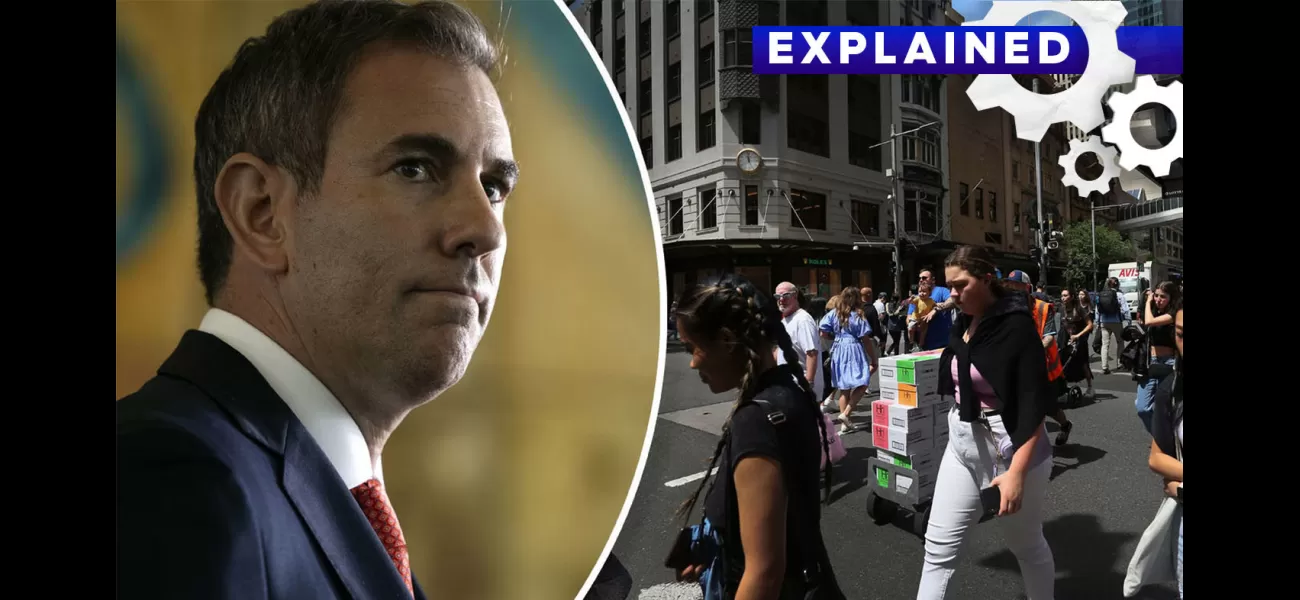A look at what's included in next week's federal budget.
Jim Chalmers will announce various measures on May 14 to reduce cost of living, including tax cuts and debt relief.
May 7th 2024.

The federal budget, set to be released on May 14, has some promising news for students. The government has announced several cost-of-living relief packages that will benefit students in many ways. These changes are expected to be a central part of the budget, although Treasurer Jim Chalmers has cautioned that there won't be any extravagant cash splashes.
One of the major changes announced today is the Commonwealth Prac Payment, a support payment for students in teaching, nursing, midwifery, and social work programs who are on workplace placements. This payment will provide $319.50 per week to students during their placements and is expected to benefit around 73,000 students. However, it won't come into effect until July 1, 2025.
Another significant policy change is the way HECS-HELP debt is indexed. In the past, student debt has increased every year in line with inflation. However, the government has now decided to index it to the lower of either inflation or the wage price index. This move was recommended by the Australian Universities Accord review and will provide relief to students who have been facing increasing debt for years. It will also be applied retroactively from June 1, 2023, reducing this year's projected hike.
The government estimates that this change will provide about $3 billion in relief to over 3 million individuals with student debt. Additionally, Education Minister Jason Clare has hinted at further changes to higher education in the budget, with more responses to the Universities Accord to be revealed. However, the specifics of these changes are still unknown.
Another popular measure that will be included in the budget is the stage 3 tax cuts. These cuts, announced in January and passed by parliament in February, aim to redirect more of the benefits towards low- and middle-income earners. This will help alleviate the burden of rising living costs and also address bracket creep. The tax rates for the lowest two brackets will be lowered, while the threshold for the two highest brackets will be raised.
Compared to the original stage 3 tax cuts proposed by the previous government, these changes will have a slightly different impact. The original plan did not lower the tax rate for the first two brackets and would have also abolished the 37 per cent bracket and increased the threshold for the top bracket to $200,001.
In addition to these measures, the government has also hinted at other policies that will provide relief to Australians. These include changes to the higher education funding model and increasing the number of fee-free places. The full details of these policies will be revealed on May 14 when the budget is released.
Students are about to receive a lot of benefits from this year's federal budget. The government has announced several cost-of-living relief packages that will greatly benefit students. While the budget will not be revealed until May 14 by Treasurer Jim Chalmers, it is clear that changes to HECS-HELP indexation and a new $320-a-week payment for students on placement will be major components.
Chalmers has cautioned that the budget will not include any major cash splashes, but there are still significant policies being introduced to ease financial burdens. Some policies, such as the stage 3 tax cuts, have already been announced, while others have been hinted at without many details. Here is what you can expect from the federal budget and how much you can benefit from these plans.
One of the most eagerly awaited announcements for students was the relief of student debt and support for placements. Both Prime Minister Anthony Albanese and Chalmers had previously mentioned cost-of-living relief for students, and two policies have now been announced with more expected on May 14. The first is the Commonwealth Prac Payment, a support payment for students studying teaching, nursing, midwifery, and social work while on workplace placements. This payment of $319.50 per week will be means-tested and is expected to benefit around 73,000 students. However, it won't take effect until July 1, 2025.
The second measure is the change to the way HECS-HELP debt is indexed. Previously, student debt would rise in line with inflation every year on June 1. However, this will now change, with debts being indexed to the lower of either inflation or the wage price index. This change, recommended by the Australian Universities Accord review, will prevent students from facing a debt that is increasing faster than their earning power through no fault of their own. Additionally, it will be backdated to June 1, 2023, providing relief to those who were hit by the record 7.1% increase due to high inflation. This year's projected hike will also be reduced from 4.7% to 4%. These changes are expected to provide approximately $3 billion in relief to the more than 3 million people with student debt.
There will also be further changes to higher education included in the budget, with Education Minister Jason Clare teasing more responses to the Universities Accord on May 14. However, the specifics of these changes are still unknown. The review made 47 recommendations, including establishing a $10 billion future fund to invest in the sector, altering the university funding model, and increasing the number of fee-free places.
Another significant aspect of this year's budget is the stage 3 tax cuts. This policy, announced in January and passed by parliament the following month, aims to direct more of the benefit towards low- and middle-income earners. This will help ease cost-of-living pressures and address bracket creep. The cuts lower the tax rate for the lowest two brackets and raise the threshold for the two highest brackets, meaning individuals need to earn more to be taxed at those higher rates. This differs from the original stage 3 tax cuts introduced by the Morrison government, which did not lower the tax rate for the first two brackets and would have abolished the 37% bracket and raised the threshold for the top bracket to $200,001.
Overall, students can expect significant relief from financial burdens thanks to the federal budget. With policies such as the Commonwealth Prac Payment, changes to HECS-HELP indexation, and stage 3 tax cuts, the government is taking steps to support students and alleviate their cost-of-living pressures. However, there is still much to be revealed on May 14, and it remains to be seen how much students will ultimately benefit from these plans.
One of the major changes announced today is the Commonwealth Prac Payment, a support payment for students in teaching, nursing, midwifery, and social work programs who are on workplace placements. This payment will provide $319.50 per week to students during their placements and is expected to benefit around 73,000 students. However, it won't come into effect until July 1, 2025.
Another significant policy change is the way HECS-HELP debt is indexed. In the past, student debt has increased every year in line with inflation. However, the government has now decided to index it to the lower of either inflation or the wage price index. This move was recommended by the Australian Universities Accord review and will provide relief to students who have been facing increasing debt for years. It will also be applied retroactively from June 1, 2023, reducing this year's projected hike.
The government estimates that this change will provide about $3 billion in relief to over 3 million individuals with student debt. Additionally, Education Minister Jason Clare has hinted at further changes to higher education in the budget, with more responses to the Universities Accord to be revealed. However, the specifics of these changes are still unknown.
Another popular measure that will be included in the budget is the stage 3 tax cuts. These cuts, announced in January and passed by parliament in February, aim to redirect more of the benefits towards low- and middle-income earners. This will help alleviate the burden of rising living costs and also address bracket creep. The tax rates for the lowest two brackets will be lowered, while the threshold for the two highest brackets will be raised.
Compared to the original stage 3 tax cuts proposed by the previous government, these changes will have a slightly different impact. The original plan did not lower the tax rate for the first two brackets and would have also abolished the 37 per cent bracket and increased the threshold for the top bracket to $200,001.
In addition to these measures, the government has also hinted at other policies that will provide relief to Australians. These include changes to the higher education funding model and increasing the number of fee-free places. The full details of these policies will be revealed on May 14 when the budget is released.
Students are about to receive a lot of benefits from this year's federal budget. The government has announced several cost-of-living relief packages that will greatly benefit students. While the budget will not be revealed until May 14 by Treasurer Jim Chalmers, it is clear that changes to HECS-HELP indexation and a new $320-a-week payment for students on placement will be major components.
Chalmers has cautioned that the budget will not include any major cash splashes, but there are still significant policies being introduced to ease financial burdens. Some policies, such as the stage 3 tax cuts, have already been announced, while others have been hinted at without many details. Here is what you can expect from the federal budget and how much you can benefit from these plans.
One of the most eagerly awaited announcements for students was the relief of student debt and support for placements. Both Prime Minister Anthony Albanese and Chalmers had previously mentioned cost-of-living relief for students, and two policies have now been announced with more expected on May 14. The first is the Commonwealth Prac Payment, a support payment for students studying teaching, nursing, midwifery, and social work while on workplace placements. This payment of $319.50 per week will be means-tested and is expected to benefit around 73,000 students. However, it won't take effect until July 1, 2025.
The second measure is the change to the way HECS-HELP debt is indexed. Previously, student debt would rise in line with inflation every year on June 1. However, this will now change, with debts being indexed to the lower of either inflation or the wage price index. This change, recommended by the Australian Universities Accord review, will prevent students from facing a debt that is increasing faster than their earning power through no fault of their own. Additionally, it will be backdated to June 1, 2023, providing relief to those who were hit by the record 7.1% increase due to high inflation. This year's projected hike will also be reduced from 4.7% to 4%. These changes are expected to provide approximately $3 billion in relief to the more than 3 million people with student debt.
There will also be further changes to higher education included in the budget, with Education Minister Jason Clare teasing more responses to the Universities Accord on May 14. However, the specifics of these changes are still unknown. The review made 47 recommendations, including establishing a $10 billion future fund to invest in the sector, altering the university funding model, and increasing the number of fee-free places.
Another significant aspect of this year's budget is the stage 3 tax cuts. This policy, announced in January and passed by parliament the following month, aims to direct more of the benefit towards low- and middle-income earners. This will help ease cost-of-living pressures and address bracket creep. The cuts lower the tax rate for the lowest two brackets and raise the threshold for the two highest brackets, meaning individuals need to earn more to be taxed at those higher rates. This differs from the original stage 3 tax cuts introduced by the Morrison government, which did not lower the tax rate for the first two brackets and would have abolished the 37% bracket and raised the threshold for the top bracket to $200,001.
Overall, students can expect significant relief from financial burdens thanks to the federal budget. With policies such as the Commonwealth Prac Payment, changes to HECS-HELP indexation, and stage 3 tax cuts, the government is taking steps to support students and alleviate their cost-of-living pressures. However, there is still much to be revealed on May 14, and it remains to be seen how much students will ultimately benefit from these plans.
[This article has been trending online recently and has been generated with AI. Your feed is customized.]
[Generative AI is experimental.]
0
0
Submit Comment





